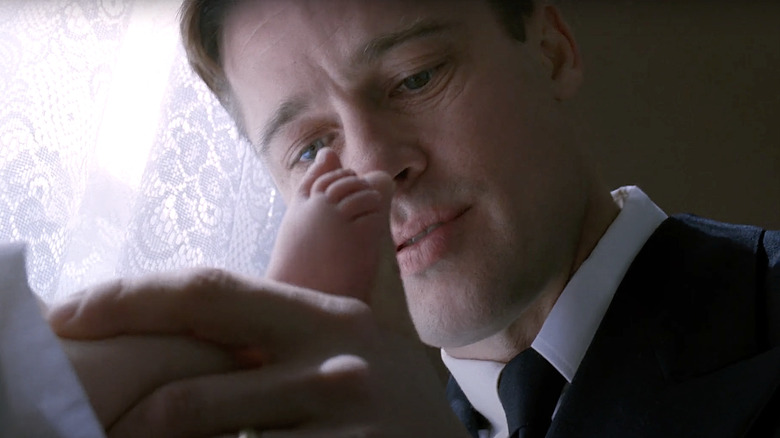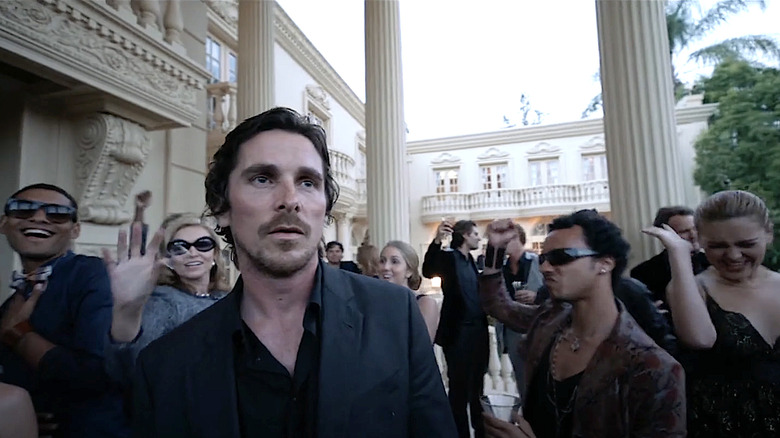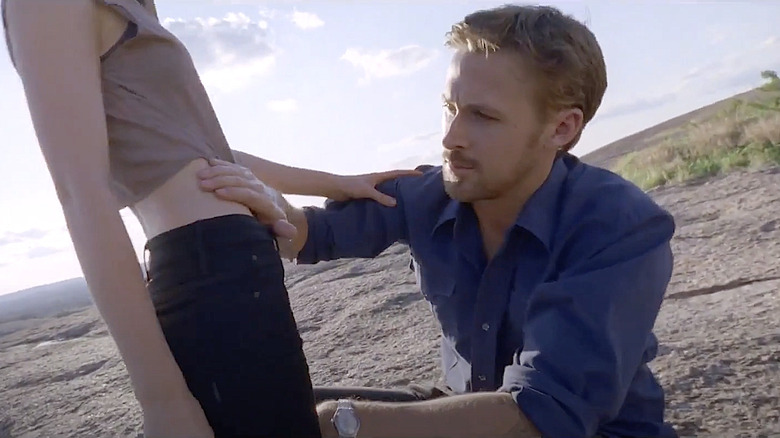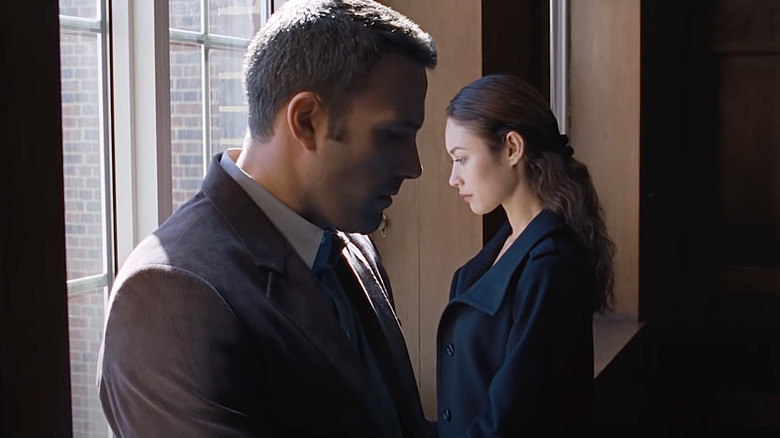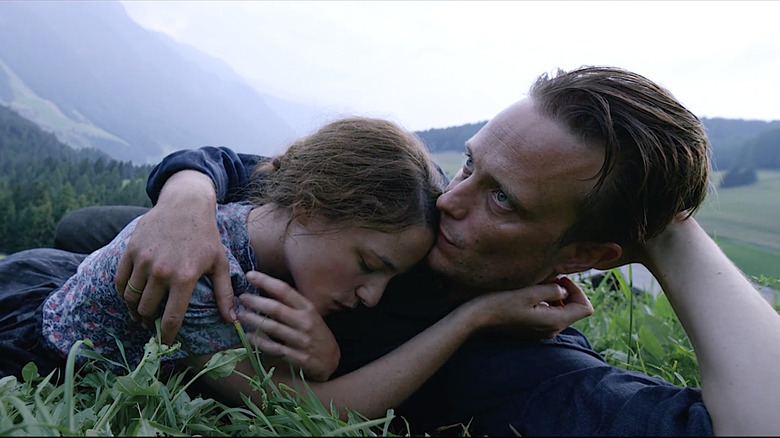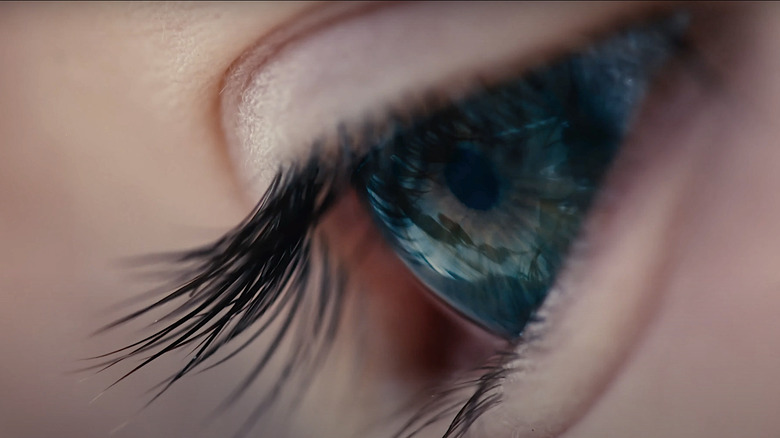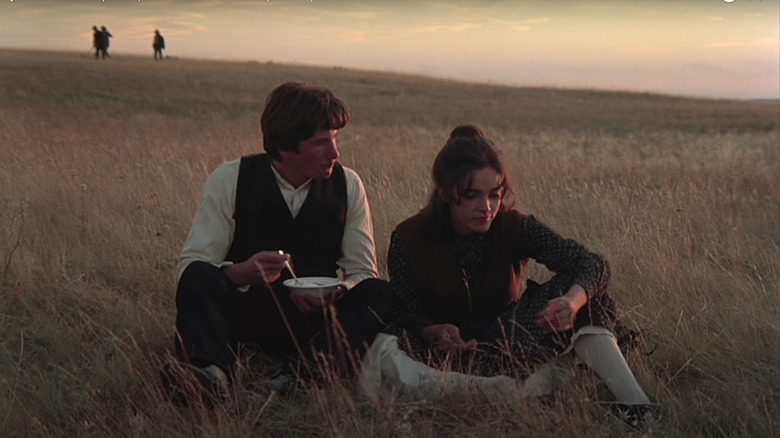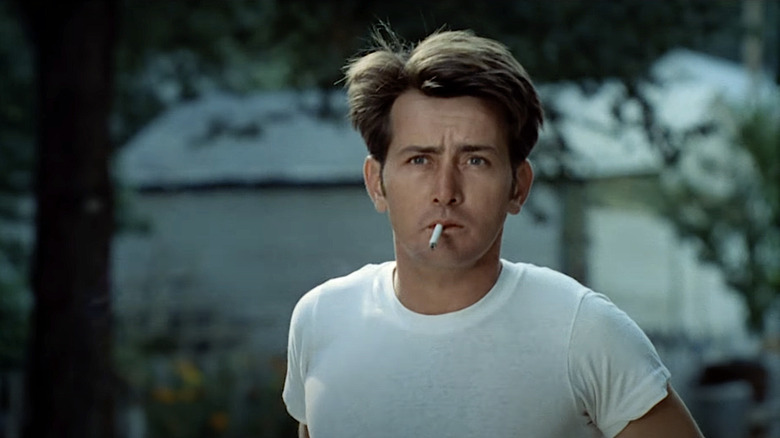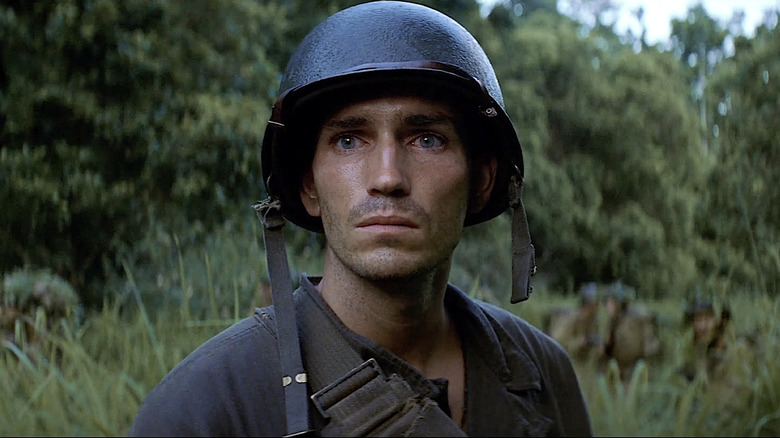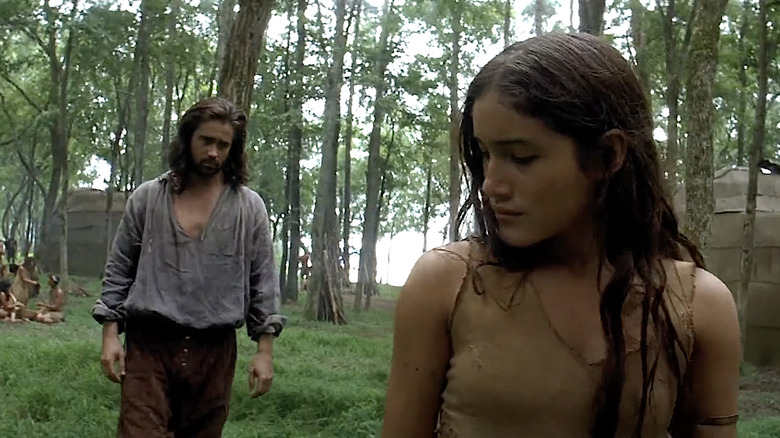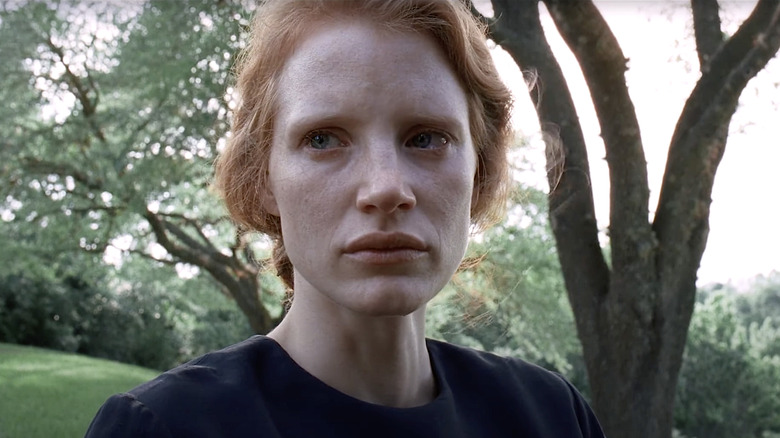Every Terrence Malick Movie Ranked From Worst To Best
Once a decade or so, Terrence Malick would crawl out of whatever primordial netherworld that nourishes his mind and make a movie. After his stunning sophomore effort, 1978's "Days of Heaven," the auteur vanished for 20 years. When he returned in 1998, he delivered another ethereal classic, "The Thin Red Line."
So grew Malick's legend. But as he's entered his later years, the spirit has really moved him. After 2011's "The Tree of Life," Malick became unexpectedly prolific, adding numerous shorts and even an ambitious IMAX documentary to his IMDb page, when he wasn't busy penning the script for his next feature-length rumination on the meaning of life. This has not been all good, exactly. Malick's once unblemished filmography is now marred with some misses, but through familiarity we've finally gotten to know the mind of Hollywood's most enigmatic auteur.
Audiences interested in story-driven dramas featuring characters with clear motives going on grand adventures will find Malick either incomprehensible or tedious. He's never filmed a car chase or shootout, and he's never been interested in chasing the MacGuffins. His films are meant to evoke feelings that we can't easily put into words — which is probably why his movies have hardly any dialogue. Malick is still working more feverishly than ever, and it's definitely an open question as to what he's going on about — and which of his effusive works is his masterpiece.
10. Knight of Cups
Part of the problem with late-career Malick is technology. There's just less artistic value in a well-shot montage in an era when the iPhone can assemble competent cuts completely unprompted and anyone can download stunning stock cinematography from sites like Artgrid. When your average Facebook mom can take an epic time-lapse video of a sunset, Malick's visual moves no longer have such pop.
In Tarot, the Knight of Cups represents the "classic romantic." Here, Christian Bale plays an emotionally detached Hollywood screenwriter who experiences life as if trapped from the inside – he's an introverted observer, or a "spy," as one lover notes. His life in Los Angeles is a blur of decadent parties and manic pixie dream girls. This knight's cup truly runneth over. Bale's character sees the beauty in it all, but something is missing.
Despite the film's extreme Malickean form factor (there's not a single diegetic conversation in two hours), it's also an open-minded critique of polyamorous urbanites who may find themselves watching their loveless love lives, rather than taking part. Malick makes no condemnations, but Bale's character is living out a dazzling and depressing sunk cost fallacy. He's drunk on Tinseltown's trappings at the cost of his human soul — or maybe that's just what it feels like sitting through this ponderous visual poem.
9. Song to Song
Any sane cinephile should be interested in a Terrence Malick film starring Ryan Gosling and Michael Fassbender. But the opening scene of 2017's "Song to Song" — if Malick's recent films could even be said to contain scenes — is set in a chaotic rave. It's the kind of relentlessly repetitive music that even fans will admit you need drugs to enjoy. Some would say the same for the director's later movies.
"Song to Song, a spiritual sequel to "Knight of Cups," is heavy on formless whimsy. Rooney Mara plays a struggling songstress who tries to get ahead by dating a sketchy record producer played by Fassbender. When she meets a charming musician played by Gosling, their love is real, but she continues her twisted affair with Fassbender until the lies ruin her happiness.
"Song to Song" is partly about the spiritual cost of the modern sexual shuffle, but it's most interested in Mara's character's shallow and fruitless duplicity. She mistakes sexual freedom for liberation as she ponders her descent into decadence. The soul isn't fed by merely collecting pleasures, Malick seems to preach, but while Mara still longs for Gosling, the universe may have moved on. Emotional entropy, it turns out, is more linear than this film. "Song to Song" is another Malick mood-piece, and unless you're into the auteur's late-career ticks, this deconstructed dud quickly feels played out.
8. To the Wonder
"To the Wonder" centers on Ben Affleck and French actress Olga Kurylenko, who play a young-ish couple with the typical affectations of Malick's late-career movies about people drunk on love: they coo at each other and make silly gestures with the playful whimsy of children, all while whispering half-formed pieces of existentialism over erratically edited montages.
When Affleck falls out of love with Kurylenko, the two pointlessly drift apart. Affleck plays a man without a purpose. He works as some kind of environmental engineer, observing the damage industry and suburban sprawl is doing to the once pristine plains of Oklahoma. The degradation of nature is all part of his fall from grace. At one point, Affleck rekindles a romance with an old flame played by Rachel McAdams. The two walk through a field of buffalo, a once-plentiful species famously destroyed by human rapacity.
Once you get the hang of Malick's quirks, they become easier to spot. Despite the well-trodden territory, the film's commentary about the emptiness of a rootless life works. The director has three later films, including this one, that made critics fed up with his sophistry. Audiences, meanwhile, were never sure what Malick is up to, so there's not really anyone left to defend him, even when he does something sort of good.
7. A Hidden Life
"A Hidden Life" is Terrence Malick's return to semi-sensical narrative form. It's also a return to the Second World War.
Based on a true story, August Diehl plays Franz Jägerstätter, an Austrian peasant and loving family man who becomes a conscientious objector after being drafted into the Nazi war machine. No amount of prodding can persuade him to heil Hitler. The film's only real flaw is its three-hour run time. The upside of auteur theory is we get artists like Malick. The downside is that it's hard to curb their excesses.
According to No Film School, this is also Malick's first fully digital film. Malick's long-time DP Emmanuel Lubezki is absent. Instead, "A Hidden Life" was shot by Jörg Widmer, Malick's long-time camera operator. This continuity keeps Malick's style intact: the flowing camera movements, and the close-ups with lenses so wide they're almost fisheye. But Widner's camera is actually more restrained than Lubezki's, and that helps ground this tragic true story about a man who stood firm against one of the greatest evils in human history. Jägerstätter never had any inkling his courage would be known. His sacrifice was hidden. "Conscience makes cowards of us all," one of Jägerstätter's Nazi jailers tells him. Nothing could be further from the truth.
6. Voyage of Time
Malick's 21st century films are largely a search for God. Malick has looked under every rock for transcendence: from forests to foxholes; from familial love to sexual lust; from piety to decadence. "Voyage of Time" is technically an IMAX documentary, but it's made in the same spirit as his other late works, this time exploring the origins of life itself.
Stylistically, Malick stays on brand. Over the course of about 40 minutes, Brad Pitt delivers whimsical narration over Paul Atkins' beautiful cinematography (at least in one version; there's also a 90-minute cut that replaces Pitt with Cate Blanchett). This is a rare opportunity to see Malick shorn down, and it makes you wonder how many of his later films could be saved with a sharp set of scissors.
"Voyage of Time" is absolutely meant for IMAX. If you are not immersed in these images, the towering orchestral score, and Pitt's wonderfully wispy voice work, you're missing the point. Malick is taking you inside his spiritually inclined mind. The vague shape of a documentary replaces his paper-thin plots and gets straight to the point. He's ensconcing you in grand natural imagery to elicit a metaphysical way of knowing. Despite the best efforts of theologians like Thomas Aquinas and C.S. Lewis, God has no persuasive logical proofs, and the best rationalist arguments were always weak. Malick understands the limits of philosophy, and so asks a simpler question: Can you feel it?
5. Days of Heaven
In "Days of Heaven," Richard Gere and Brooke Adams play a young couple, Bill and Abby, who flee the Upton Sinclair-esque working conditions of Chicago factories in the early 20th century. This 1978 film is another "Bonnie & Clyde"-inspired adventure about youthful love on the lamb.
The couple pretends to be siblings and finds a piece of paradise on a farm in the Texas panhandle, but the labor is just as backbreaking as the work they did before. When the handsome and wealthy farm owner (Sam Shepard, around age 36) falls in love with Abby, Bill discovers that the man is fatally ill. Bill can't bear to see Abby toil in the fields, and the couple comes up with a devil's bargain: Abby will accept the dying farmer's proposal and improve their station forever.
This is Malick's second film, and if we were discussing any other director, it'd likely be their best. It also started his practice of shooting the majority of his films around magic hour – that gilded moment just after sunset when the whole of Earth's atmosphere becomes one giant bounce board. The director's other signatures are present too: understated performances, musing voice-overs, and a dearth of diegetic dialogue. Malick's moral mind is also unwavering. When Bill trades love for money, even if the sacrifice was made for Abby's sake, he's bartered with flesh and spirit for an earthly prize. That's no way to stay aloft in this warmly lit slice of heaven.
4. Badlands
"Badland's is Terrence Malick's remarkable 1973 debut. He was barely 30 when it was made, and yet it announced the arrival of a mature American artist with something to add to the conversation.
That conversation largely revolved around the impact of "Bonnie and Clyde," starring Warren Beaty and Faye Dunaway. If you went to film school any time in the last 20 years, your syllabus was likely heavy on late '60s and '70s films from "New Hollywood." The groundbreaking thing about "Bonnie and Clyde" was how stylistically violent it is, even if it's tame by modern standards. "Badlands" is "Bonnie and Clyde" meets Adam and Eve, and it's a professorial favorite too, especially for its fixation on macro (close-up) nature cinematography.
But you hardly need a Ph.D. to get into the earthy rhythms of Malick's first work. "Badlands" is interspersed with shots of flowers and insects, which serve as a tonal counter to the violent inciting incident. Martin Sheen and Sissy Spacek play outlaws who become half-cocked homesteaders, but not just for the thrill of it. Their romantic passion resulted in a crime, and the two are forced into hiding in Montana's actual Badlands. Malick circled back to the theme of lovers who return to a state of nature decades later, and it's thrilling to see this fixation come out in its first beautiful incarnation.
3. The Thin Red Line
"The Thin Red Line" is Terrence Malick's massive World War II ensemble piece about the gory American battles on Guadalcanal. The cast is so star-studded that it features Jared Leto as a glorified extra. Adrien Brody was cast as the film's lead, and yet hardly appears. Mickey Rourke, Billy Bob Thornton, and Bill Pullman were cut entirely.
The eastern theatre is introduced with haunting shots of an otherworldly jungle paradise, and this reflection: "What's this war in the heart of nature? Why does nature vie with itself?" Young Indigenous boys swim freely in gorgeous underwater shots as they fish — or, perhaps, play. What's the difference in a paradise like this? Jim Caviezel, who plays a soldier gone AWOL, is like the war's living conscience, looking upon these children with reverie. Through his wide, longing eyes, we see that the modern world and its mechanized evil have returned to Eden as a side effect of civilized conflict.
Malick's greatness is that his observations aren't political, but spiritual. Malick's modus operandi is always mood, which he communicates with his evocative cinematic language. But his questions can be deduced: Is there some natural law that made the terrors of the 20th century inevitable? And, even if it's through death, is there any way back from this brink?
2. The New World
It's easy to imagine an adult film about John Smith and Pocahontas being a grim sermon on exploitation, but Terrence Malick is too much of a humanist for this kind of binary. Since he's mostly interested in spirituality, both the Capulets and the Montagues must have souls.
2005's "The New World" is about the fall of an Eden. It's also one of the most beautiful stories about star-crossed lovers ever put to celluloid. Colin Farrell's soulful eyes make his John Smith the perfect vessel for Q'orianka Kilcher's radiant, achingly beautiful elegance as Pocahontas. Christian Bale deserves an honorable mention as the princess' jilted suitor. Instead of becoming a villain, as lesser filmmakers might make him, he bears his unrequited love with a dignity that proves his devotion.
Farrell has always felt underrated, even in the '00s when he was Hollywood's go-to guy. Maybe his matinee-idol looks and wild lifestyle took away from his genuine on-camera genius. He and Kilcher are one of the few convincing couples in Malick's canon. Their tragic romance will renew your faith in the spiritual force of love, and then remind you that the harsh world beneath always has the last say.
1. The Tree of Life
"The Tree of Life" is Terrence Malick's magnum opus, the genuine culmination of a life's work, and it's befuddling as it is beautiful. If you were lucky enough to catch it in a theater, the confused chatter in the lobby as the credits rolled was worth the price of admission.
Casting Brad Pitt probably attracted many filmgoers who had no idea what they were walking into. This is Malick at his most poetic and contemplative. The plot covers the entirety of time and space, only to zoom down into the lives of one family in 1950s Texas. You get the sense that, if Malick had his druthers, he'd communicate entirely in whale sounds and wide shots of crashing waves. But the family story, centered on a young boy's relationship with his stern father (Pitt) and his luminous mother (Jessica Chastain), is necessary if he wants to reach us humans. Sean Penn plays Jack all grown up, and no actor is better at letting inner anguish wash over their face.
Russian filmmaker Sergei Eisenstein is often credited with codifying "montage" (i.e, editing shots together to derive meaning) in filmmaking. "The Tree of Life" takes that old idea to its logical extreme. Rules often make art effective, but here, Malick takes you to the brink, then back again. All that you can do is worship the truth and beauty of his vision.
